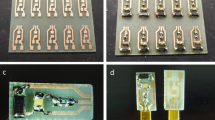Abstract
The aim of this work is to present a room-temperature plastination technique developed in our laboratories and its results. This technique emphasizes the use of silicones, catalysts, and generic hardeners, and some variations of the traditional technique resulted in low cost and high-speed implementation. Two hands, a heart, and a brain were dissected from Caucasian adult undefined-gender cadavers previously kept in 5 % formalin solution. Also dissected was a pig heart kept in 5 % formalin solution. Dehydration was performed for 1 month at room temperature to favor defatting. Afterwards, forced impregnation took place. The average process for each specimen lasted 3 or 4 days, 8 h a day (active forced impregnation), halting the forced impregnation overnight (passive forced impregnation). Once 5 mmHg had been reached without bubbling and the vacuum process had ended, specimens were drained and positioned. Finally, curing was performed by subjecting the specimens to cross-linker. The different morphological characteristics of the specimens determined variations in the forced impregnation time, as well as curing. Once polymerization was complete, specimens were stored in plastic bags, facilitating internal curing. Three kinds of silicones were used: Biodur, North Carolina, and a local generic. The catalyst and the hardener were generic products also acquired locally. Based on our technique, we obtained completely dry and rigid specimens, of excellent quality and durability, which kept their original color and anatomical shape.







Similar content being viewed by others
References
Baptista CAC, Cerqueira EP, Conran PB (1988) Impregnation of biological specimens with resins and elastomers: plastination with Biodur S10 resin. Rev Bras Cienc Morfol 5(1):60–62
Baptista CAC, Bellm P, Plagge MS, Valigosky M (1992) The use of explosion proof freezers in plastination: are they really necessary? J Int Soc Plast 6:34–37
Bickley HC, von Hagens G, Townsend FM (1981) An improved method for the preservation of teaching specimens. Arch Pathol Lab Med 105(12):674–676
Bravo H (2006) Plastination an additional tool to teach anatomy. Int J Morphol 24(3):475–480
Briggs CA, Robbins SG, Kaegi WH (1997) Development of an Anatomical Technologies Laboratory. J Int Soc Plast 12(2):8–11
Chaynes P, Mingotaud A-F (2004) Analysis of commercial plastination agents. Surg Radiol Anat 26:235–238
deJong K, Henry RW (2007) Silicone plastination of biological tissue: cold-temperature technique Biodur S10/S15 technique and products. J Int Soc Plast 22:2–14
Gubbins RBG (1990) Design of a plastination laboratory. J Int Soc Plast 4:24–27
Henry RW (2007a) Silicone plastination of biological tissue: cold-temperature technique. J Int Soc Plast 22:15–19
Henry RW (2007b) Silicone plastination of biological tissue: room-temperature technique North Carolina technique and products. J Int Soc Plast 22:26–30
Henry RW, Janick L, Henry C (1997) Specimen preparation for silicone plastination. J Int Soc Plast 12(1):13–17
Latorre RM, García-Sanz MP, Moreno M, Hernández F, Gil F, López O, Ayala MD, Ramírez G, Vázquez JM, Arencibia A, Henry RW (2007) How useful is plastination in learning anatomy? J Vet Med Educ 34(2):172–176
McCreary J, Iliff S, Hermey D, McCreary K, Henry RW (2013) Silicone-based coloration technique developed to highlight plastinated specimens. J Plast 25(2):13–20
O’Sullivan E, Mitchell BS (1995) Plastination for gross anatomy teaching using low cost equipment. Surg Radiol Anat 17:277–281
Ottone NE, Cirigliano V, Lewicki M, Bianchi HF, Aja Guardiola S, Algieri RD, Cantin M, Fuentes R (2014) Plastination technique in laboratory rats: An alternative resource for teaching, surgical training and research development. Int J Morphol 32(4): XX–XX (In press)
Raoof A (2001) Using a room-temperature plastination technique in assessing prenatal changes in the human spinal cord. J Int Soc Plast 16:5–8
Raoof A, Henry RW, Reed B (2007) Silicone plastination of biological tissue: room-temperature technique Dow/Corcoran technique and products. J Int Soc Plast 22:21–25
Sakamoto Y, Miyake Y, Kanahara K, Kajita H, Ueki H (2006) Chemically reactivated plastination with Shin-Etsu silicone KE-108. J Int Soc Plast 21:11–16
Smodlaka H, Latorre R, Reed RB, Gil F, Ramírez G, Váquez-Autón JM, López-Albors O, Ayala MD, Orenes M, Cuellar R, Henry RW (2005) Surface detail comparison of specimens impregnated using six current plastination regimens. J Int Soc Plast 20:20–30
Steinke H, Spanel-Borowski K (2006) Coloured plastinates. Ann Anat 188:177–182
Zheng T, Jingren Liu, Kerming Zhu (1998) Plastination at room temperature. J Int Soc Plast 13(2):21–25
von Hagens G (1979) Impregnation of soft biological specimens with thermosetting resins and elastomers. Anat Rec 194(2):247–255
von Hagens G (1986) Heidelberg Plastination Folder; Collection of all technical leaflets for plastination. Anatomisches Institut 1, Universitat Heidelberg, Heidelberg
von Hagens G, Tiedemann K, Kriz W (1987) The current potential of plastination. Anat Embryol (Berlin) 175(4):411–421
Conflicts of interest
The authors declare that they have no conflicts of interest.
Author information
Authors and Affiliations
Corresponding author
Rights and permissions
About this article
Cite this article
Ottone, N.E., Cirigliano, V., Bianchi, H.F. et al. New contributions to the development of a plastination technique at room temperature with silicone. Anat Sci Int 90, 126–135 (2015). https://doi.org/10.1007/s12565-014-0258-6
Received:
Accepted:
Published:
Issue Date:
DOI: https://doi.org/10.1007/s12565-014-0258-6




